Play all audios:

ABSTRACT Bacon and Bell1 isolated and identified fructose in fœtal sheep's blood. This was the first conclusive proof of its existence prenatally. They also showed it disappears from
the blood of the new-born lamb within three days of birth. During 1948 we performed experiments designed to throw some light on the mode of formation and site of origin of this fructose.
Cæsarean section was performed under spinal anæsthetic supplemented by pentothal (which we find to be without effect on the blood sugar). The ewe was immersed in saline at 38° C. into which
the fœtus was delivered. Blood samples were taken from the maternal dorsalis pedis artery and the umbilical vein. The total reducing substances and the fructose were estimated by the
Somogyi–Nelson2 method and the Cole3 modification of the Roe's method respectively. The difference was taken as an approximate measure of the glucose. Access through your institution
Buy or subscribe This is a preview of subscription content, access via your institution ACCESS OPTIONS Access through your institution Subscribe to this journal Receive 51 print issues and
online access $199.00 per year only $3.90 per issue Learn more Buy this article * Purchase on SpringerLink * Instant access to full article PDF Buy now Prices may be subject to local taxes
which are calculated during checkout ADDITIONAL ACCESS OPTIONS: * Log in * Learn about institutional subscriptions * Read our FAQs * Contact customer support SIMILAR CONTENT BEING VIEWED BY
OTHERS FRUCTOSE MIGHT BE A CLUE TO THE ORIGIN OF PREECLAMPSIA _INSIGHTS FROM NATURE AND EVOLUTION_ Article 20 December 2022 BLOOD _MYO_-INOSITOL CONCENTRATIONS IN PRETERM AND TERM INFANTS
Article 15 September 2020 UNUSUAL FREE OLIGOSACCHARIDES IN HUMAN BOVINE AND CAPRINE MILK Article Open access 24 June 2022 REFERENCES * Bacon, J. S. D., and Bell, D. J., _Biochem. J._, 40,
xlii (1946). * Nelson, N., _J. Biol. Chem._, 153, 375 (1944). CAS Google Scholar * Cole, S. J., described in ref. 1. Download references AUTHOR INFORMATION AUTHORS AND AFFILIATIONS *
Physiology Department, St. Mary's Hospital Medical School, London, W.2 A. ST. G. HUGGETT, F. L. WARREN & V. N. WINTERTON Authors * A. ST. G. HUGGETT View author publications You can
also search for this author inPubMed Google Scholar * F. L. WARREN View author publications You can also search for this author inPubMed Google Scholar * V. N. WINTERTON View author
publications You can also search for this author inPubMed Google Scholar RIGHTS AND PERMISSIONS Reprints and permissions ABOUT THIS ARTICLE CITE THIS ARTICLE HUGGETT, A., WARREN, F. &
WINTERTON, V. Origin and Site of Formation of Fructose in the FŒtal Sheep. _Nature_ 164, 271 (1949). https://doi.org/10.1038/164271a0 Download citation * Issue Date: 13 August 1949 * DOI:
https://doi.org/10.1038/164271a0 SHARE THIS ARTICLE Anyone you share the following link with will be able to read this content: Get shareable link Sorry, a shareable link is not currently
available for this article. Copy to clipboard Provided by the Springer Nature SharedIt content-sharing initiative
